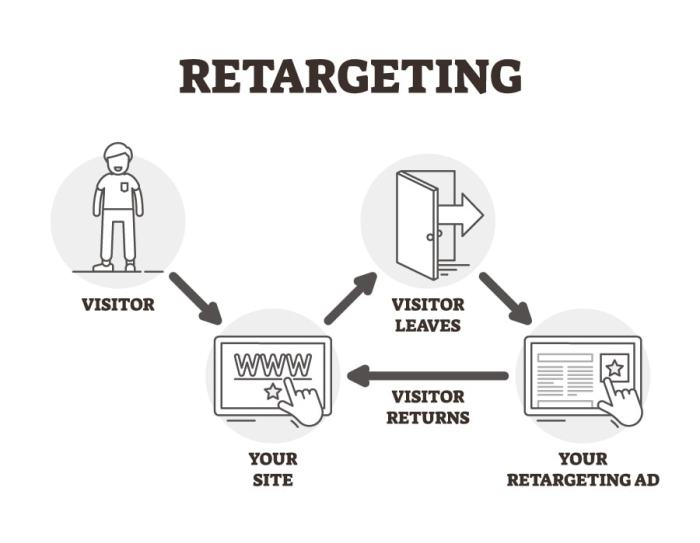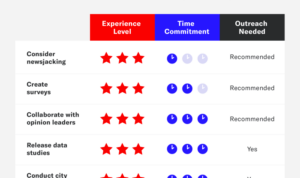Using Retargeting Ads takes center stage in the digital marketing realm, offering businesses a powerful tool to boost conversions and enhance brand visibility. Get ready to dive into the world of retargeting ads with a twist of American high school hip style.
As we unravel the different facets of retargeting ads, you’ll gain valuable insights into how this strategy can revolutionize your marketing efforts.
Introduction to Retargeting Ads
Retargeting ads are a powerful digital marketing tool that allows businesses to show targeted ads to users who have previously visited their website or interacted with their brand in some way. These ads work by using cookies to track users’ online behavior and then displaying relevant ads as they browse the internet.Retargeting ads are essential in digital marketing strategies because they help businesses stay top of mind with potential customers, increase brand awareness, and drive conversions.
By showing ads to users who have already shown interest in the brand, retargeting ads have a higher chance of converting leads into customers.
Examples of Successful Retargeting Ad Campaigns
- Amazon: Amazon uses retargeting ads to show products that users have viewed but not purchased, reminding them to complete their purchase.
- Netflix: Netflix uses retargeting ads to promote new releases to users who have previously watched similar content on the platform.
- Zappos: Zappos uses retargeting ads to show users products they have viewed or added to their cart but not purchased, encouraging them to complete the purchase.
Benefits of Using Retargeting Ads

Retargeting ads offer various advantages for businesses looking to enhance their marketing strategies. These ads are designed to target users who have previously interacted with a brand’s website or mobile app, making them more likely to convert. By staying top of mind with potential customers, retargeting ads can significantly impact conversion rates and brand awareness.
1. Increased Conversion Rates
Retargeting ads have the power to bring back potential customers who may have shown interest in a product or service but did not make a purchase initially. By displaying relevant ads to these users as they browse the internet, businesses can remind them of what they were interested in and encourage them to complete their purchase. This personalized approach often leads to higher conversion rates compared to traditional advertising methods.
2. Improved Brand Awareness
Through retargeting ads, businesses can reinforce their brand messaging and offerings to users who have already engaged with their brand. This repeated exposure helps in building brand awareness and recognition among potential customers. Even if users do not make an immediate purchase, seeing the brand’s ads across various platforms can leave a lasting impression, making them more likely to consider the brand in the future.
Types of Retargeting Ads

When it comes to retargeting ads, there are three main types that businesses can utilize to reach their target audience effectively. These include pixel-based retargeting, list-based retargeting, and email retargeting.
Pixel-Based Retargeting
Pixel-based retargeting involves placing a tracking pixel on your website, which then tracks visitors as they browse the internet. When these visitors leave your site without making a purchase, they will be shown targeted ads on other websites they visit. This type of retargeting is effective in reminding potential customers about products they viewed on your site.
List-Based Retargeting
List-based retargeting involves uploading a list of customer emails or contact information to a retargeting platform. The platform then matches this information with user profiles to display targeted ads to these specific individuals. This type of retargeting is effective in reaching out to a specific audience that has already shown interest in your products or services.
Email Retargeting
Email retargeting involves sending customized emails to individuals who have visited your website but did not make a purchase. These emails are personalized based on the products or services they viewed on your site. This type of retargeting is effective in nurturing leads and encouraging them to complete a purchase.By utilizing these different types of retargeting ads, businesses can increase their chances of converting potential customers into actual buyers.
Examples of businesses successfully using these strategies include online retailers like Amazon, who use pixel-based retargeting to remind customers of products they viewed, and SaaS companies like Salesforce, who use email retargeting to nurture leads and encourage sign-ups.
Best Practices for Implementing Retargeting Ads
Implementing retargeting ads can be a powerful strategy to re-engage with potential customers who have shown interest in your products or services. To create a successful retargeting ad campaign, follow these key steps:
Segment Audiences Effectively, Using Retargeting Ads
When it comes to retargeting ads, segmenting your audiences effectively is crucial for optimizing your ad spend and increasing conversions. Here are some tips to help you segment your audiences:
- Utilize website behavior: Segment your audiences based on the specific actions they have taken on your website, such as pages visited, products viewed, or items added to cart.
- Use customer demographics: Consider segmenting your audiences based on demographics such as age, gender, location, or interests to tailor your retargeting ads to specific groups.
- Implement time-based segmentation: Create segments based on the time elapsed since a user’s last interaction with your website to deliver timely and relevant retargeting ads.
Optimizing Ad Creatives for Better Engagement
To ensure your retargeting ads capture the attention of your audience and drive conversions, it’s essential to optimize your ad creatives. Here are some tips for optimizing ad creatives for better engagement:
- Create compelling visuals: Use high-quality images or videos that are visually appealing and relevant to your target audience to grab their attention.
- Craft personalized ad copy: Tailor your ad copy to resonate with different audience segments, addressing their specific needs, pain points, or interests.
- A/B test your creatives: Experiment with different ad creatives, headlines, and calls-to-action to identify which variations perform best and optimize your campaigns accordingly.
Challenges of Using Retargeting Ads
When utilizing retargeting ads as part of your marketing strategy, there are several challenges that you may encounter. It is crucial to address these challenges effectively to maximize the success of your retargeting campaigns.
Ad Fatigue
One common challenge faced with retargeting ads is ad fatigue, where your audience becomes tired of seeing the same ads repeatedly. This can lead to a decrease in engagement and click-through rates.
To overcome ad fatigue, it is essential to rotate your ad creatives regularly and test different ad formats to keep your audience engaged. Additionally, segmenting your audience based on their behavior can help you deliver more relevant ads to prevent fatigue.
Ad Blocking
Another challenge is ad blocking, where users use ad-blocking software to prevent ads from being displayed. This can significantly reduce the reach of your retargeting campaigns.
To combat ad blocking, consider using native advertising or sponsored content that is less likely to be blocked. You can also provide valuable content to your audience to build trust and encourage them to whitelist your site.
Conversion Attribution
Tracking conversions and attributing them to your retargeting ads accurately can be challenging, especially with multiple touchpoints in the customer journey. Without proper attribution, it may be difficult to measure the effectiveness of your retargeting campaigns.
To address this challenge, implement multi-touch attribution models that consider all touchpoints along the customer journey. Utilize tools like Google Analytics or Facebook Pixel to track conversions and attribute them correctly to your retargeting efforts.
Monitoring and Adjustment
One of the most critical challenges is the lack of monitoring and adjustment of retargeting ad strategies. Without continuous monitoring and optimization, you may miss out on valuable insights and fail to improve the performance of your campaigns.
It is essential to regularly monitor key performance metrics such as click-through rates, conversion rates, and return on ad spend. Analyze the data to identify trends and make data-driven adjustments to your retargeting ad strategies for better results.

